fa
fa
See map + walking directions online and offline .
Gustav Adolf Square, Hereditary Prince’s Palace.

SOPHIA ALBERTINA AEDIVICAVIT shines in gold letters at the top of the Hereditary Prince’s Palace. That means ”built by Sofia Albertina, sister of Gustav III”.
In 1783, the princess bought Torstensson’s palace on Fredsgatan and built the house into what is today the residence of the Ministry of Foreign Affairs.

Architect Erik Palmstedt designed the facade facing the square, which also included a former guardhouse and mill at Strömmen. The facade became a mirror image of Gustav III’s opera, which had just been inaugurated on the other side of the square.

Thirty years old and unmarried. She kept a large court in apartments at Drottningholm and other castles. How could Sofia Albertina afford it? Perhaps an inheritance from her mother Lovisa Ulrika, who died in 1782, contributed. But the dowager queen had tangled affairs and had to sell Drottningholm to the state. Gustav III contributed to Sofia’s coffers, despite a tense relationship.
Sofia was her mother Lovisa Ulrika’s spoiled girl. Consequently, she was in conflict with her brother Gustav III, who contributed to her remaining unmarried. Suitors were repelled by a changeable temperament, at times domineering like her mother. In addition, she was plump, hunched over, windy-eyed and with a hooked nose like a little old woman according to her cousin Charlotta (princess who became queen and then cheated on her Charles XIII with Axel Fersen the Younger ).
Sofia and Gustav’s building projects angered. The opera was inaugurated in 1782. Magnificent palace constructions were planned outside the Haga. Many believed that the king fled to Italy in the summer of 1783 when famine plagued the people after several years of crop failure. Even worse was the cold winter after the Laki volcanic fissure in Iceland covered the northern hemisphere in a haze of ash and poisonous gas. (See BBC about Laki ).
The painter Adrien Louis Masreliez decorated the halls of Sofia Albertina’s palace. Foreign Minister Bildt has his study in the living room where the princess and her ladies-in-waiting used to hang out. The late Gustavian style and Gustav III are on the walls. For Bildt, this is a scary symbolism, as the king had been a foreign policy disaster since he made himself his own foreign minister in 1783. Gustav would have gone to war with his queen’s homeland, Denmark, if the Russian empress had not intervened.
With the same purpose, he went on the return trip from Italy to Louis XVI in Paris. Apart from an island in the West Indies and a sum of money, no support was given for a war. In addition, Gustav came into conflict with his maternal uncle Frederick the Great in Prussia. Then add the feud with his mother and sister Sofia Albertina. In modern language, the monarch lacked social skills, both nationally and internationally.
The foreign policy fiasco led to Gustav III starting a war against Russia in 1788 after a fake border battle. Carl Bildt’s ancestor Didrik Bildt participated as commander of the Bohus battalion when a grenade tore off his leg. Carl Bildt played as a child at Morlanda manor on Orust where the particularly wicked Didrik is said to haunt his wooden leg. The family ties are shown both at the House of Knights .hythythjyt
Sofia inherited from her mother the black lackey Gustav Badin , an all-rounder who burned the letters in which Lovisa Ulrika spread rumors that Gustav III was not the father of the heir to the throne.
Lovisa Ulrika received ten-year-old Badin, born a slave in the West Indies, as a gift. The queen had read Rousseau so the natural child received ”a free upbringing” and became a mischievous and playful boy at court. According to malicious tongues, also the lover and father of Sofia Albertina’s children.
In her later years, Sofia became an abbess in Germany. She donated the palace as a trust for princes without a right to the throne, hence the name Hereditary Prince’s Palace . Prince Carl Philip could have lived there if the state had not bought the house in 1902.

Not many people notice the memorial to Raoul Wallenberg next to the entrance to the Ministry of Foreign Affairs, nor the Holocaust Monument on Raoul Wallenberg Square in front of Berzeli Park. Trade and crafts probably weighed more heavily than religious freedom when Gustav III allowed Jews to settle in Stockholm.
Although the contradictory autocrat was also a man of the Enlightenment, influenced by Voltaire, which, in addition to religious tolerance, led to the abolition of torture methods and certain death penalties.
Gustav Adolf Square.
The square was formerly called Malmtorget and Norrmalmstorg, where people would gather to watch executions until the end of the 17th century. The streets converge at this geographical center of the city.
It was therefore natural for the Dalarna farmers to gather here in the Great Valley Dance. They were angry after the failed Russian war of the hats, in which the Dal Regiment had participated in Finland the year before. In the Siljan region, they wanted to change the system of government and have a Danish prince as heir to the throne.
The messengers left Mora and 15,000 (?) peasants marched to Stockholm, led in the background by the regiment’s major Vilhelm Gustaf Wrangel . In the square they were met with the news that the Russian empress had forced Adolf Fredrik on them as heir to the throne as a condition of peace.
The troops around the square fired wildly into the crowd. 150 died, 3000 were captured and the rest fled. The leaders were punished and Wrangel was put in a fortress. At that time there was no TV like at the battle of the elms in Kungsträdgården so the Valley Uprising is pretty much swept away from history. Listen to this presentation .
Gustavian Opera House, Gustav Adolfs torg . The last masquerade of the year, March 16, 1793.
The royal carriage that has driven from the pavilion outside Haga stops in front of the gate with the columns (with largely the same facade as the Hereditary Prince’s Palace on the other side of the square).
The king and his courtiers hurry up to the banquet in the Drabantsalen upstairs. There, Gustav III receives an anonymous letter from a page warning him not to attend the masquerade ball .
Wearing the masquerade costume, the king stands in the round window, known as the bull’s eye, clearly visible to the partygoers, but nothing happens. Then the party goes down to the royal box down by the stage. Up at the wings, Gustav III is surrounded by men in black masks.

One of the conspirators, Count Claes Horn, is heard saying ”Good evening, beautiful mask”. The shot with scrap burns off and the king sits down on a bench wounded in the weak life. The assassins are held back when the gates close and the revolution takes off. Two found pistols reveal Johan Jacob Anckarström , who is executed. The other conspirators can thank Prince Karl (later King with number XIII) for their easy escape.
The king is led up for treatment in the small cabinet, at the top behind the gallery. Gustav III is then carried out in a rococo chair to the carriage that takes him to the palace where he dies two weeks later. Public masquerade balls were banned until 1896.

Carl Fredrik Adelcrantz was commissioned by the king to design the opera house based on French models , which was opened in 1782. It was demolished and replaced in 1896 by the ”cigar boxes”
| Gustav Adolf Square | |
| 28. Walk northeast on Gustav Adolfs torg towards Västra Trädgårdsgatan. | 80 m |
| 29. Continue onto Jakobs torg. The finish line is on the right. | 16 m |
| Jacob’s Square | |
| 30. Walk northeast on Jakobs torg towards Karl XII:s torg | 70 m |
| 31. Turn right to Karl XII’s Square | 91 m |
| 32. Turn left onto Strömgatan, Fersenska Palace away towards Grand Hotel | 60 m |
| 33. Slight left turn to continue on Strömgatan | 32 m |
| 34. Turn left onto Kungsträdgårdsgatan | 100 m |
| 35. Turn left towards Jakobs torg | 99 m |
Kungsträdgården, the statue on Charles XII’s square. Charles XII and his sister Ulrika Eleonora were the only rulers in the 16th and 17th centuries who did not start wars. Consequently, he is called the warrior king, celebrated with a statue in 1868 by the nationalists of the time.
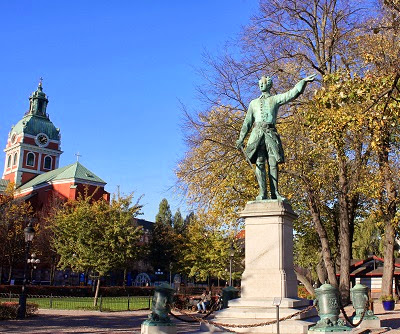
No Swedish king rode as much as Charles XII. Consequently, he stands there without a horse. With extra long sleeves, he points his finger at the Russian. Strangely enough, it was the theater man August Blanche and other liberal forces who were behind the collection to finance the statue. The bronze uniform is the same one he wore in Fredrikshald (displayed in the Livrustkammaren at the castle). The four mortars come from a victory at Riga.
Kalabalik is a riot in Turkish. And there were riots, and not just in Bender. When the statue was to be unveiled, conservatives set up a royal grandstand that obscured the event. Riots broke out when an angry crowd was whipped bloody by mounted police. August Blanche missed the inauguration, because on the way there he died of a heart attack at the Ugglan pharmacy (which still stands opposite the PUB on Drottninggatan).
There was also a whipping from the police during the battle over the elms in 1978. As can be seen, the thirteen hundred-year-old elms still stand between the king’s statue and Molin’s fountain – both with Johan Peter Molin as the foundryman.
The subway exit was placed east on Arsenalsgatan, where you can see remains of de la Gardie’s magnificent Makalös, the castle that during the Great Power era was located on the same site as the statue of Charles XII.

Fersenska Palace between Blasieholmstorg and Stockholms ström.
July 20, 1810. The palace staff is terrified this morning. Only the Royal Marshal Axel von Fersen remains calm as he and his beloved sister Sophie Piper eat breakfast , despite all the rumors in town that they have poisoned Prince Carl August during a maneuver in Skåne. The coachman refuses to drive Fersen’s seven-glass carriage in the funeral procession.
Yesterday, the Marshal of the Realm himself drove the six-horse carriage to Haga, but was only allowed to converse with the ladies-in-waiting because King Charles XIII refused to receive him. Outside, horse-drawn carriages and boats stood in Brunnsviken ready for the escape of the king and his Hedvig Elisabeth Charlotta – whose friend and mistress Sophie Piper had previously been before she took over the household for the bachelor Fersen.
The siblings took over the palace from their father, the late Councilor Axel von Fersen. This politician had rebuilt the Wachtmeister Palace with Carl Hårleman’s help, largely as we see it today. The Fersen Terrace was created in the 1880s by Helgo Zetterman (the same architect who designed the neighboring Palmeska House and the Riksdag House). Handelsbanken uses the palace for representation. Anyone who is not invited to a tour will have to make do with seeing the house like this .
When Fersen gets into the carriage, a valet pulls out a ticket with an anonymous warning of lynching, which is ignored. Fersen has been through worse, like when he fled with Louis XVI and Fersen’s beloved Marie Antoinette. Or when he fought against the British in the American Revolutionary War in 1781 and in Finland against the Russians in 1788,
Fersen’s seven-horse carriage with a count’s crown on the roof and drawn by six white horses is easy to recognize. The carriage’s four lackeys and the troops from the Svea Life Guards are of no help when the Marshal of the Realm is torn apart half-naked on Stora Nygatan.
Despite her close relationship with the queen, Sophie Piper fears for her own life when she receives the news of her death. Dressed as a milkmaid, she trips down the palace stairs to a small boat waiting at Skeppsholmen. The same stairs where she was otherwise carried in a litter for the sake of her health. (And the same stairs where Stig Trenter parked a dead person in the detective story Lek lilla Louise). Soaked in the pouring rain, Sophie sails along the coast and finds shelter in the Norrtälje area.
The Royal Garden.
In the 15th century, Erik of Pomerania grew vegetables on this land next to Jakob’s cemetery. Gustav II Adolf planted boxwood hedges so that royalty and nobles could walk undisturbed within the enclosure. Gustav III opened the park to the public. At that time, Makalös served as an arms depot, hence the name Arsenalen, before it burned down in 1825.
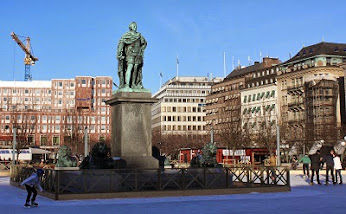
Karl XIV Johan liked exercise and replaced the plantings with a gravel field. He celebrated the anniversary of his adoption by erecting a statue of his benefactor Karl XIII. On the desolate field, skaters have replaced the jacks. In the summer, the children are photographed on the four lions.
Unlike Charles XII, who was surrounded by four pots, the malice joked that here was a pot surrounded by four lions.
Kungsträdgården, St. Jacob’s Church. A good place to rest the apostle’s horses because St. Jacob is the patron saint of travelers. Thank Johan III, who started construction in 1580, for the strict late Gothic basic form. It was not until 1643 that St. Jacob’s Church was consecrated. Queen Christina was there and probably thought about how she could become Catholic; abdication perhaps?

The Renaissance is visible in the gates, among other things. Like the north gate, it is reminiscent of the old cemetery. Next to it is a plaque commemorating the poet Johan Henrik Kellgren . Maybe he is up at night to continue the fight with Bellman .
In the cemetery you can mourn your ancestors. Or check your emails on your mobile phone.
The roof burned when lightning struck the tower in 1723. The new tower was designed by Guran Josua Adelkrantz, father of the architect Carl Fredrik. Carl Hårleman contributed the tower hoods. The interior has been restored to its original 16th and 17th century appearance. The mini museum displays, among other things, a baptismal font, donated by the neighbor De la Gardie at the Makalös palace.
| 35. Turn left towards Jakobs torg | 99 m |
| 36. Continue straight ahead to Jakobs torg | 85 m |
| 37. Turn right onto Västra Trädgårdsgatan | 47 m |
| 38. Turn left onto Jakobsgatan | 260 m |
| 39. Turn right onto Drottninggatan | 47 m |
| 40. Turn left onto Karduansmakargatan | 89 m |
Karduansmakargatan, Adelcrantzska palatset. The only reason to enter the street is for the palace , which the architect Carl Fredrik Adelcrantz built himself in 1755.

Admittedly, you only see the gable facing the street, because the tenant, the Ministry of Finance, has locked itself in so you can neither enter the courtyard nor see the rococo interior. Adelcrantz could afford it because he was the architect of the moment. He designed, for example, Adolf Fredrik’s Church, the Royal Opera House and the palace theatres at Drottningholm and Ulriksdal.
The palace is the only house left after the ravages of the excavators around 1960. Then Svenska Dagbladet and Klarabohemerna disappeared from the street. Which today looks more like a backyard for the Ministry of Industry and Trade and other GDR-inspired architecture in the neighborhood. Not even prostitutes from Malmskillnadsgatan, which meets this street at Brunkebergstorg, dare to go here at night. Karduansmakargatan got its name from the tanners (karduansmakarna), who prepared exclusive goat skins here. Compare the street in 1962 and today.
| Karduansmakargatan | |
| 41. Head southwest on Karduansmakargatan | 50 m |
| 42. Turn right onto Herkulesgatan | 69 m |
| 43. Turn left at Klara Tunnel | 17 m |
| 44. Turn right towards Vattugatan | 130 m |
| 45. Turn right onto Vattugatan | 57 m |
| 46. Turn left onto Klara Södra kyrkogata | 100 m |
| 47. Turn right onto Klara Västra kyrkogata | 94 m |
| 48. Turn right to continue on Klara Västra kyrkogata. The destination is on the right side. | 14 m |
Klara Cemetery, Klara Västra kyrkogata. In the cemeteries, the walker meets celebrities from the 18th century, in several cases as tombstones erected by the Swedish Academy. Words on the way are given in Lennart Hellsing’s new book Lunch at Klara Cemetery . From his office, he sees the lunch break people setting out the takeaways on the gravestones.
In their imagination, they meet Cajsa Warg rising from the coffin in the Klinckowska tomb choir (hidden on the north side of the church). “Burgers and raw fish / as the Japanese teach them!” Hellsing’s verses are as witty as Anna Maria Lenngren’s , also with a stone here.

”Politely declined ’Salad of the Day’ / but not a glass” is dedicated to Carl Michael Bellman who was buried in a pauper’s grave north of the church. The grave is gone because under the memorial stone there is a hill. Life above is Bellman-like with homeless people and addicts who the church helps.
The pulpit was designed by Carl Hårleman, the grave owner also in Hellsingboken. With a little luck, you might see 90+ Lennart Hellsing walking among the stones, as he lives right next door.
| Klara Västra kyrkogata | |
| 49. Head northwest on Klara Västra kyrkogata towards Klarabergsviadukten | 41 m |
| 50. Turn right onto Klarabergsgatan | 200 m |
| 51. Turn left onto Drottninggatan | 500 m |
| Queen Street |
Drottninggatan 59, Apoteket Ugglan. In the same location since 1798 and is the country’s oldest pharmacy.
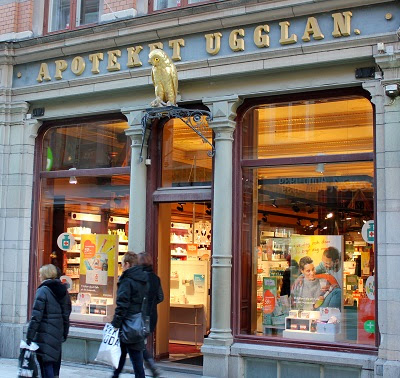
The pharmacist Olof Johan Cöster then moved a pharmacy that was previously located at Hötorget there. It was originally supposed to be called Älgen, but such a sign was difficult to get up, so it had to be called the Ugglan pharmacy .
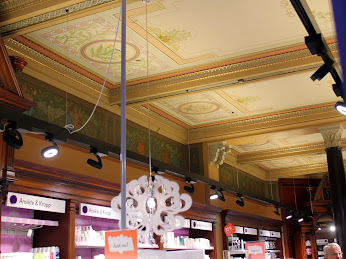
The interior is from the late 19th century.
August Blanche died in the arms of pharmacist Tisell in 1868. On his way from the unveiling of the Charles XII statue in Kungsträdgården, the playwright/publicist felt a pang in his heart and stumbled into the pharmacy.
The pharmacy is located between Gamla Brogatan and Bryggargatan, where Taimour Abdulwahab blew himself up among Christmas shoppers in 2010.
Old Bridge Street
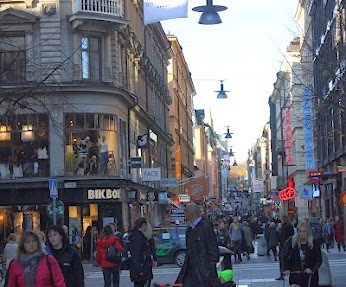
The best street if you want to experience old Klara before the excavators’ lustful murder in the neighborhoods. The 18th century stone houses closest to Drottninggatan are gone. To the west were simple wooden shacks on what was then called Kungsbrogatan and stretched across Klara Lake beyond Kungsholmen.
Bellman’s complicated business affairs forced the family to move frequently in the neighborhood, including to Lilla Munklädersgatan (which was later erased by the railway). He died in 1795 in the courtyard of the Bourdillska house at the intersection of Brogatan and Målargatan.
The regicide Anckarström is said to have lived in the apartment below, where he sold milk from his own cowshed on the farm. His money lending probably didn’t do much in these poor neighborhoods. Anckarström lost his head in 1792, so the question is whether he met Bellman.

If you look into the courtyard from Gamla Brogatan 30, the centuries-old atmosphere of Vete-katten’s outdoor terrace is revived. For now, because soon the block will be rebuilt into a luxury hotel.
It’s a shame that more farm environments aren’t opened up to restaurants and shops, like in many cities abroad.
Drottninggatan 88, Hårlemanska malmgården in Centralbadsparken. Enter through the wrought iron gate and encounter an oasis that mixes the 17th and 19th centuries. The Hårleman House Drottninggatan 88b was built in 1710 but was given its Rococo character by the newlywed Carl Hårleman in 1748. The architect quickly adopted the graceful Louis XV style he learned during his French trip. Now good taste and comfort were the order of the day, breaking away from the pompous construction of the old school. He tried to apply this when completing Stockholm Palace.

Although he had a free hand on his own ore farm – and for that matter also on the construction of the Observatory Museum, which he was responsible for until his death in 1753.
Hårleman must have liked the house’s China store, because he decorated the China Pavilion that King Adolf Fredrik surprised his queen with at Drottningholm.
The nobility built manor-like farms on the ores already during the great power era. Then the wealthy burghers did not want to be worse. The upper class wanted to live healthily in the summer and cultivate large gardens outside the city buildings. In the filth of the city, more people died than were born, so the population decreased during the first half of the 18th century.
The Centralbad park is a remnant of such a garden, although it took shape in the late 19th century when the Centralbad was built. The owner also made sure to decorate the ore farm in the style of the time.
.
The environment is literary. Stig Trenter had a widow murdered in the house. The Writers’ Association is located at Drottninggatan 88A. But Hjalmar Söderberg did not frequent Rydberg’s on the street level. The restaurant takes its name from the classic entertainment establishment Rydberg’s Hotel, which was located at Gustav Adolf’s Square before the First World War. Which does not prevent you from being served a Rydberg steak, why not after a dip in the venerable Centralbadet .
| 52. Continue on Drottninggatan | |
| 53. Turn right onto Wallingatan | 93 m |
| 54. Turn left onto Holländargatan. The church is on the right. | 2m |
Holländargatan, Adolf Fredrik’s Church. During the 18th century, no churches were built in Stockholm. The population shrank and only regained its numerology from the great power era towards the end of the century.

The only exception is Adolf Fredrik’s church, with the foundation stone laid by the king of the same name. Gustav III inaugurated the nearly completed building in 1774, shortly after Adolf Fredrik’s congregation broke away from Klara.
Although the Rococo style is partly visible, architect Carl Fredrik Adelcrantz had the opportunity to tighten up the architecture in a neoclassical way, in what is known in the country as the Gustavian style. From his sky, or from Google maps , the architect can see the church spread out like a Greek cross.
The classical inspiration was diluted by Gustav III and Sergel’s Italian trip. The sculptor’s altar sculpture is dedicated to the French philosopher René Descartes, whom Queen Christina recruited to an untimely death in Stockholm. 19th-century lull-lull changed the furnishings, but the altar and Adlercrantz pulpit are original.
Hjalmar Branting has a tall gravestone erected towards Holländargaten; in the direction of Norrtullsgatan, where he lived and next to the Observatory where he studied stars.
Olof Palme is content with a simpler stone. Much of his life revolves around the neighborhood – Juridicum, the student union, the S-HQ, ABF, the Grand cinema and the murder scene.
Holländargatan 28, (Rådmansgatan), Rucklet. Did Anckarström really live here before the regicide? There is no evidence, but the dramaturgy tickles the imagination.
When Gustav III went from Haga to the opera, he didn’t see many stone houses around the observatory. It was mostly countryside with small cottages and windmills up on the hills.
The rubble on Holländargatan was dangerously close to the ridge where Stockholmers collected gravel. Some of it was used to fill in the marshlands in what is still called Träsket along Sveavägen.
From these poor neighborhoods came many of the children who were left by unwed mothers in the public orphanage, which stretched from Drottninggatan to Barnhusgatan. Gustav III reasoned that orphanage work and foster homes would be preferable to infanticide.

After studying law at Norrtullsgatan, Olof Palme stayed in Rucklet. He worked for an international student organization, which some say was an extension of the CIA. In any case, Palme didn’t have to take many steps up Holländargatan in 1968 to shut up with the students who had occupied their own student union building. Neither there nor in Rucklet are there any student parties anymore.
| 57. Turn left onto Rådmansgatan | 90 m |
| 58. Turn right onto Drottninggatan. The haunted castle is on the right. | 62 m |
Drottninggatan 116, Schefflerleska Palace. Those who dare should visit the Ghost Park and the Ghost Castle at night. Perhaps you can hear the howls of Hans Petter Scheffler, who had the ore farm built around 1700, modeled after a 17th-century French palace.

The house did not last that many summers because he died in 1707, worth just over 200,000 riksdaler. He was buried north of the palace, where his skeleton could later be seen in a rotting coffin. The choir had cracked and Scheffler’s ghost was free to jog howling in the park.
The haunted palace’s basement vault was once said to extend all the way to Döbelnsgatan. ”Rumor has it that people have found remains of people walled up in the basement,” says the building’s curator Nina Weibull. She hears unexplained coughing in empty rooms, but otherwise her job is to show the 200 works of art up on the main floor.
Nina Weibull, world-famous for the roses she named, talks vividly about paintings from the Dutch 16th/17th century, Rococo and Swedish from the 18th/19th century. But only at arranged viewings. Otherwise, the university keeps the premises for its own festivities; with a preference for the Great Hall that Scheffler opened with gold leather wallpaper.

In 1779, the same year as the American Revolution, mill owner Jakob von Balthazar Knigge bought the palace. There he acquired a reputation for being so extremely wicked that in 1796 he was fetched by the devil in a fire-breathing carriage at breakneck speed.
Before that, the jealous husband managed to kill his young wife, who is said to still haunt the room where she was locked up. Evidently a legend for Anna Maria von Balthazar Knigge did not die until 1825 and then gave Lovisa Bellman a generous pension. Bellman’s widow had lived in poverty for a couple of decades when she was employed by Anna Maria in 1814 as a landlady in the ore farm. Despite the rumor, Jacob Knigge was also philanthropic, including a large donation to the Widow’s House.
However, there is a truth hidden behind the ghosts. One August night in 1875, the opera singer Gustav Sandström was heard playing in the house and the next morning he shot himself with a revolver. A few days earlier, in the opera Faust, he had sung ”I die like a brave soldier.”
Drottninggatan 120, Observatoriekullen. The cobblestones of Drottninggatan stretched up to Spökslottet. Then they had to drive on sand so as not to disturb the instruments in the Observatory up on the hill, which is a remnant of Brunkebergsåsen.
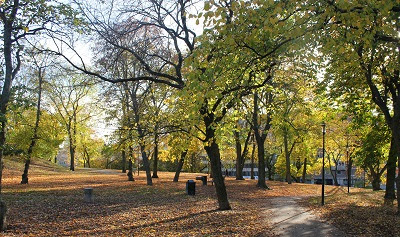
Before 1929, ordinary people were not allowed into the park. The fence was put up because the noise in the park outside disturbed the astronomers. At night, people stole sand from the bank towards Sveavägen, or Badstugatan as the street was called then.
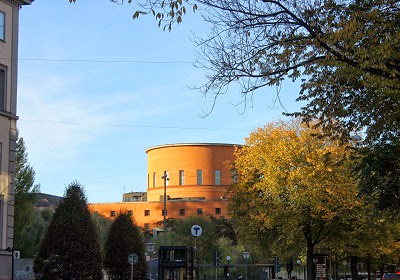
Down there, Birger Asplund has created a functional park between his City Library and the Stockholm School of Economics. It was obvious that more gravel would have been dug into the hill if the construction of a new city library had been completed.
The English park on the hill , which we still enjoy, was designed by architect Carl Fredrik Adelcrantz shortly before his death in 1796.
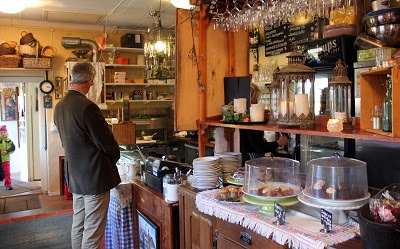
The winding paths lead up to the Observatory with the Himlavalvet café in one wing. The restaurant is closed in winter and the Observatory Museum is in danger of closing for good soon. Read more in “Save Stockholm’s most forgotten museum”.
